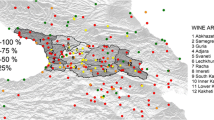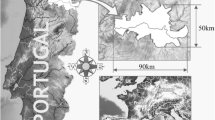Abstract
The growth of the grapevine is determined largely by temperature, thus it is essential to investigate the role of temperature in crop phenology. This study takes into account three diverse cultivars of grapevine never studied phenologically in this area, on three farms in the province of Macerata (Central Italy, east side).The end of flowering date was chosen for the significance of the growth transition from the plant to the berries. Preventive climate analysis was implemented by GIS software through the cokriging geostatistical method to spatialize temperature, using altitude as the independent variable. The phenological dates of the cultivars of grapevine were related to temperatures iteratively, creating a new method for calculating growing degree days, on the basis of 4 key (cardinal) temperatures which influence plant growth. This study represents the first step towards creating an identity card for the three studied grapevines, as a tool to improve quality and quantity of yield.







Similar content being viewed by others
References
Allen JC (1976) A modified sine wave method for calculating degree days. Environ Entomol 5:388–396
Bradley E (1983) Estimating the error rate of a prediction rule: improvement on cross-validation. J Am Stat Assoc 78(382):316–331
Cannell MGR, Smith RI (1983) Thermal time, chill days and prediction of budburst in Picea Sitchensis. J Appl Ecol 20:951–963
Cesaraccio C, Spano D, Snyder RL, Ducea P (2004) Chilling and forcing model to predict bud-burst of crop and forest species. Agric Forest Meteorol 126:1–13
Chai T, Draxler RR (2014) Root mean square error (RMSE) or mean absolute error (MAE)? Arguments against avoiding RMSE in literature. Geosci Model Dev 7:1247–1250
Cola G, Mariani L, Parisi S, Failla O (2010) Tempo termico e fenologiadellavite. Acta italus hortus 3:31–34, Trento
Cola G, Failla O, Maghradze D, Megrelidze L, Mariani L (2017) Grapevine phenology and climate change in Georgia. Int J Biometeorol 61:761–773
De Réaumur (1738) Observations du thermomètre, Faites à Paris pendant l’année M.DCCXXXV. Comparées avec celles qui ont été faites sous la Ligne; à l’Isle de France, à Alger, & en quelques-unes de nos Isles de l’Amérique. Histoire de 11 l’Académie Royale des Sciences. Année M.DCCXXXV. A Paris, de l’Imprimerie Royale, pp 545–576
Felber R, Stoeckli S, Calanca P (2018) Generic calibration of a simple model of diurnal temperature variations for spatial analysis of accumulated degree-days. Int J Biometeorol 62(4):621–630
Ferrise R, Trombi G, Moriondo M, Bindi M (2016) Climate change and grapevines: a simulation study for the Mediterranean Basin. J Wine Econ 11(1):88–104
Fila G, Di Lena B, Gardiman M, Storchi P, Tomasi D, Silvestroni O, Pitacco A (2014) Calibration and validation of grapevine budburst models using growth-room experiments as data source. Agric Forest Meteorol 160:69–79
Fraga H, Santos JA, Moutinho-Pereira J, Carlos C, Silvestre J, Eiras-Dias J, Malheiro AC (2016) Statistical modelling of grapevine phenology in Portuguese wine regions: observed trends and climate change projections. J Agric Sci 154(5):795–811
Gentilucci M, Bisci C, Burt P, Fazzini M, Vaccaro C. (2018) Interpolation of Rainfall Through Polynomial Regression in the Marche Region (Central Italy). In Lecture Notes in Geoinformation and Cartography; Mansourian, A., Pilesjö, P., Harrie, L., van Lammeren, R. Eds.; Geospatial Technologies for All. AGILE 2018; Springer, Cham (ZG) Switzerland
Greene W (1997) Econometric Analysis, 3rd edn. Prentice-Hall, Englewood Cliffs
Hänninen H (1990) Modelling bud dormancy release in trees from cool and temperate regions. Acta Forestalia Fennica no. 213 article id 7660. https://doi.org/10.14214/aff.7660
Ishida T, Kawashima S (1993) Use cokriging to estimate surface air temperature from elevation. Theoret Appl Climatol 3:147–157
Johnston K, VerHoef JM, Krivoruchko K, Lucas N (2001) Using ArcGIS geostatistical analyst, vol 380. Esri, Redlands
Jones GV, White MA, Cooper OR, Storchmann K (2005) Climate change and global wine quality. Clim Change 73(3):319–343
Lorenz DH, Eichhorn KW, Bleiholder H, Klose R, Meier U, Weber E. (1995) Growth stages of the grapevine: phenological growth stages of the grapevine (Vitisvinifera L. ssp. vinifera)—Codes and descriptions according to the extended BBCH scale. Aust J Grape Wine Res 1(2):100–103
McMaster Gregory S, Wilhelm WW (1997) Growing degree-days: one equation, two interpretations. Agric Forest Meteorol 87:291–300
Menzel A, Sparks TH, Estrella N, Koch E, Aasa A, Ahas R, Chmielewski FM (2006) European phenological response to climate change matches the warming pattern. Glob Change Biol 12(10):1969–1976
Parker AK (2012) Modelling phenology and maturation of the grapevine Vitisvinifera L.: varietal differences and the role of leaf area to fruit weight ratio manipulations, Lincoln University, Phd Thesis
Parker AK, De Cortázar-Atauri IG, Van Leeuwen C, Chuine I (2011) General phenological model to characterise the timing of flowering and veraison of Vitisvinifera L. Aust J Grape Wine Res 17:206–216
Parker AK, de Cortázar-Atauri IG, Chuine I, Barbeau G, Bois B, Boursiquot JM, Jean-Yves Cahurel JY, Claverie M, Dufourcq T, Gény L, Guimberteau G, Hofmann RW, Jacquet O, Lacombe T, Monamy C, Ojedas H, Panigait L, Payan JC, Rodriquez Lovelle B, Rouchaud E, Schneider C, Spring JL, Storchi P, Tomasi D (2013) Classification of cultivars for their timing of flowering and veraison using a modelling approach: a case study for the grapevine species Vitisvinifera L. Agric Forest Meteorol 180:249–264
Renaud O, Victoria-Feser MP (2010) A robust coefficient of determination for regression. J Stat Plan Inference 140(7):1852–1862
Richardson EA, Seeley SD, Walker DR (1974) A model for estimating the completion of rest for Redhaven and Elberta peach trees. HortScience 9:331–332
Robinson TP, Metternicht G (2006) Testing the performance of spatial interpolation techniques for mapping soil properties. Comput Electron Agric 50(2):97–108
Roltsch WJ, Zalom FG, Strawn AJ, Strand JF, Pitcairn MJ (1999) Evaluation of several degree-day estimation methods in California climates. Int J Biometeorol 42(4):169–176
Sarvas R (1974) Investigations on the annual cycle of development of forest trees. II. Autumn dormancy and winter dormancy. Commun Inst For Fenn 84:1–101
Stocchi P, Davolio S (2017) Intense air-sea exchanges and heavy orographic precipitation over Italy: the role of Adriatic Sea surface temperature uncertainty. Atmos Res 196:62–82
Tao L, Hao X, Kang S (2016) Spatial variability of grapevine bud burst percentage and its association with soil properties at field scale. Ed. Matthew Fidelibus. PLoS ONE 11.10: e0165738. PMC.Web. 14 Jan. 2018
Wang H, Liu G, Gong P (2005) Use of cokriging to improve estimates of soil salt solute spatial distribution in the Yellow River delta. Acta Geogr Sin 60(3):511–518
Waters N (2017) Tobler's first law of geography. Int Encyclop Geogr People Earth Environ Technol. https://doi.org/10.1002/9781118786352.wbieg1011
Weikai Y, Hunt LA (1999) An equation for modelling the temperature response of plants using only the cardinal temperatures. Ann Bot 84:607–614
WMO (2003) Guidelines on climate metadata and homogenization. WMO-TD No. 1186
Zapata D, Salazar-Gutierrez M, Chaves B, Keller M, Hoogenboom G, Enol Vitic AJ (2016) Restricted access predicting key phenological stages for 17 grapevine cultivars (Vitisvinifera L.) January 2017 68:60–72
Author information
Authors and Affiliations
Corresponding author
Ethics declarations
Conflict of interest
On behalf of both authors, the corresponding author states that there is no conflict of interest.
Additional information
This paper has been selected from the 1st Euro-Mediterranean Conference for Environmental Integration, Tunisia 2017.
Rights and permissions
About this article
Cite this article
Gentilucci, M., Burt, P. Using temperature to predict the end of flowering in the common grape (Vitis vinifera) in the Macerata wine region, Italy. Euro-Mediterr J Environ Integr 3, 38 (2018). https://doi.org/10.1007/s41207-018-0079-4
Received:
Accepted:
Published:
DOI: https://doi.org/10.1007/s41207-018-0079-4




